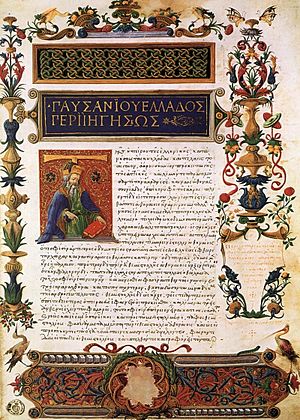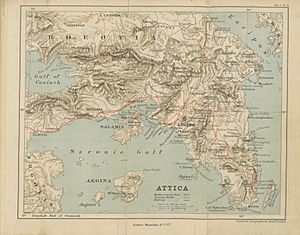Pausanias (geographer) facts for kids
Quick facts for kids
Pausanias
|
|
|---|---|

Manuscript (1485), Description of Greece by Pausanias at the Laurentian Library
|
|
| Born | c. 110 AD |
| Died | c. 180 AD (aged 70) |
| Occupation | Traveler and geographer |
Pausanias (born around 110 AD, died around 180 AD) was a Greek traveler and geographer. He lived in the second century AD. He is well-known for his long book, Description of Greece. This book describes ancient Greece based on what he saw himself.
Description of Greece is very important for connecting old Greek writings with what archaeologists find today. It helps us understand the past better.
Contents
Who Was Pausanias?
Not much is known about Pausanias, except what we can learn from his own writings. He was likely born around 110 AD in Lydia, a region in Asia Minor (which is now part of Turkey).
From about 150 AD until his death in 180 AD, Pausanias traveled all over mainland Greece. During his journeys, he wrote about many things. He described ancient monuments, sacred places, and important natural sites. His goal was to create a lasting record of "all things Greek."
Living Under Roman Rule
Even though Pausanias was Greek, he grew up and lived under the Roman Empire. The Romans ruled Greece at that time. Pausanias deeply valued his Greek identity, history, and culture.
He wanted to describe the amazing past of Greece. This past was still important during his lifetime, even though Rome was a powerful ruler. Pausanias's travels helped him connect the myths and stories of ancient Greek culture with his own time. He wanted to show how Greek heritage fit into the new Roman world.
How Pausanias Wrote
Pausanias had a clear and simple way of writing. He was usually direct in his language. He told his stories and descriptions in a straightforward style.
However, sometimes his use of verbs could be a bit confusing. For example, he might use a past tense verb when you'd expect a present tense one. Some people think he did this to make his readers feel like they were right there with him in the past.
More Than a Travel Guide
Unlike a modern travel guide, Pausanias often took detours in his book. He would stop to talk about an ancient ritual or tell a myth. These stories were often connected to the place he was visiting. This style of writing became popular again much later, in the 1800s.
Pausanias also wrote about nature. He described things like how earthquakes might be coming. He also wrote about the movement of the tides. He even mentioned the frozen seas in the north. He believed in gods and heroes, but sometimes he questioned the myths about them. His descriptions of art and buildings were simple and felt very real.
Pausanias was also honest when he didn't know something. If he quoted information from another book instead of his own experience, he would say so.
Description of Greece
Pausanias's Description of Greece has ten books. Each book focuses on a different part of Greece. He starts his journey in Attica, which includes the city of Athens.
Other books describe places like Corinth, Laconia, and Messenia. He also wrote about Elis, Achaea, Arcadia, Boeotia, Phocis, and Ozolian Locris. His project was more than just describing places. It was about the culture and history of Greece. Pausanias didn't just describe buildings and art. He also looked at the myths and history behind them.
Nature in Greece
Pausanias wasn't a scientist who studied nature. But he often commented on the natural world of Greece. He noticed the pine trees on the sandy coast of Elis. He saw deer and wild boars in the oak forests of Phelloe. He also mentioned crows among the huge oak trees of Alalcomenae.
Towards the end of his book, Pausanias wrote about natural products and fruits. He mentioned wild strawberries from Helicon. He also described date palms from Aulis and olive oil from Tithorea. He even wrote about the tortoises of Arcadia and the "white blackbirds" of Cyllene.
Religion and History
Pausanias was very interested in religion. His Description of Greece has been called a "journey into identity." This refers to his Greek heritage and beliefs. He described the religious art and buildings at famous sacred sites. These include Olympia and Delphi.
Even in remote parts of Greece, he was fascinated by religious objects. He saw statues of gods, holy relics, and other mysterious items. For example, in Thebes, he saw shields from the Battle of Leuctra. He also saw the ruins of the house of Pindar. He described statues of famous poets like Hesiod and Orpheus.
Pausanias was mostly interested in very old things. He cared less about new buildings or sacred places from his own time. He preferred the old to the new, and sacred things to everyday things. He wrote more about classical Greek art than about modern art. He focused more on temples and statues of gods than on public buildings or statues of politicians.
The end of Description of Greece is a bit of a mystery. Some people think Pausanias died before he finished his work. Others believe the strange ending was planned. He finishes his book with a story about a Greek writer. In a dream, she is told to share Description of Greece with more Greek people. This would help them understand "all things Greek."
English Versions of the Book
Pausanias's Description of Greece has been translated into English many times. A well-known version was translated by William Henry Samuel Jones. You can find it in the Loeb Classical Library.
The translation by Peter Levi is also popular. However, some think it's not a very exact translation of the original. Levi sometimes changed the book to make it more like a general travel guide. Sir James George Frazer also published a six-volume translation. His work is still considered very good by scholars today.
What People Think of Pausanias Today
For a long time, many scholars didn't think Pausanias was a very reliable source. They thought he mostly wrote about things he'd heard from others. They believed he hadn't visited most of the places he described.
However, in the 1900s, archaeologists started digging up ancient sites. They found that Pausanias was actually a very good guide! His descriptions matched what they uncovered. This showed that he was a trustworthy source.
Many scholars today continue to study Pausanias and his Description of Greece. Many books and articles have been written about him. His recorded travels are still a useful tool. They help us understand the connections between archaeology, mythology, and history.
See also
 In Spanish: Pausanias (geógrafo) para niños
In Spanish: Pausanias (geógrafo) para niños


